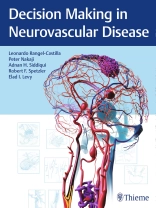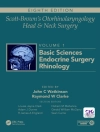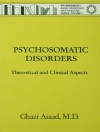Neurovascular medicine has emerged as an established, semi-independent subspecialty of neurology and neurosurgery. Decision Making in Neurovascular Disease focuses on the challenging process of determining the best approach for managing patients with intracranial atherosclerosis, carotid artery disease, stroke, aneurysms, arteriovenous malformations, arteriovenous fistulae, cavernous malformations, and hypervascular tumors. Leonardo Rangel-Castilla, Robert Spetzler, esteemed coauthors, and an impressive cadre of experts discuss highly divergent modalities including medical management, open cerebrovascular, endovascular, radiosurgery, and combined/multimodality alternatives.
The book is organized into seven sections: Ischemic Stroke and Vascular Insufficiency, Aneurysms – Anterior Circulation, Aneurysms – Posterior Circulation, Aneurysms – Other, Arteriovenous Malformations and Fistula, Cavernous Malformations, and Hypervascular Tumors. Chapters include an introduction, decision-making algorithm, whether to treat, conservative management, anatomical considerations, clinical and imaging evaluation, differential diagnosis, treatment options, images, clinical and radiographic follow-up, and suggested reading.
Key highlights:
- Simple algorithms accompanying 71 chapters supported by the latest, most updated information in the literature
- More than 300 radiologic images help elucidate disease-specific treatment decision making
- Step-by-step guidance, clinical pearls, surgical nuances, complication avoidance, and evidence-based outcomes provide in-depth understanding
- Point/counterpoint expert commentary on each case provides balanced insights on potential implications of specific treatments
This essential step-by-step book is a must-have for residents and fellows in neurosurgery, neurology, endovascular, interventional radiology, vascular neurology, and neurocritical c
Inhoudsopgave
I Ischemic Stroke and Vascular Insufficiency
1 Acute Ischemic Stroke: Small Vessel Disease
2 Acute Ischemic Stroke: Large Vessel Occlusion
3 Acute Ischemic Stroke: Acute Internal Carotid Artery Occlusion and Tandem Lesions
4 Acute Basilar Artery Occlusion
5 Intracranial Atherosclerotic Disease
6 Asymptomatic Extracranial Carotid Artery Stenosis
7 Symptomatic Extracranial Carotid Artery Stenosis
8 Vertebrobasilar Stenosis and Insufficiency
9 Vertebral Artery Ostium Stenosis
10 Pediatric Moyamoya Disease
11 Adult Moyamoya Disease
12 Traumatic and Iatrogenic Carotid Artery Injury
13 Traumatic and Iatrogenic Vertebral Artery Injury
14 Spontaneous Internal Carotid Artery Dissection
15 Spontaneous Vertebral Arterial Dissection
16 Chronic Internal Carotid Artery Occlusion
17 Cerebral Venous Thrombosis and Occlusion
II Aneurysms—Anterior Circulation
18 Cervical Carotid Artery Aneurysms
19 Cavernous Carotid Artery Aneurysms
20 Cave Carotid Artery Aneurysms
21 Superior Hypophyseal Artery Aneurysms
22 Ophthalmic Artery Aneurysms
23 Posterior Communicating Artery Aneurysms
24 Anterior Choroidal Artery Aneurysms
25 Internal Carotid Artery Bifurcation Aneurysms
26 Middle Cerebral Artery Aneurysms
27 Distal Middle Cerebral Artery Aneurysms
28 Anterior Cerebral Artery Aneurysms
29 Anterior Communicating Artery Aneurysms
30 Pericallosal Artery Aneurysms
31 Giant Aneurysms of the Anterior Circulation
32 Fusiform Aneurysms of the Anterior Circulation
33 Dissecting Intracranial Aneurysms of the Anterior Circulation
34 Traumatic Intracranial Aneurysms of the Anterior Circulation
35 Previously Coiled Recurrent Aneurysms of the Anterior Circulation
36 Previously Clipped Recurrent Aneurysms of the Anterior Circulation
III Aneurysms—Posterior Circulation
37 Vertebral Artery Aneurysms
38 Midbasilar Artery Aneurysms
39 Basilar Artery Apex Aneurysms
40 Posterior Cerebral Artery Aneurysms
41 Superior Cerebellar Artery Aneurysms
42 Anterior Inferior Cerebellar Artery Aneurysms
43 Posterior Inferior Cerebellar Artery Aneurysms
44 Giant Aneurysms of the Posterior Circulation
45 Fusiform Aneurysms of the Posterior Circulation
46 Dissecting Intracranial Aneurysms of the Posterior Circulation
47 Traumatic Intracranial Aneurysms of the Posterior Circulation
48 Previously Coiled/Clipped Recurrent Aneurysms of the Posterior Circulation
IV Aneurysms—Other
49 Mycotic Intracranial Aneurysms
50 Blood Blister–Like Aneurysms
51 Pediatric Intracranial Aneurysms
52 Spinal Aneurysms
V Arteriovenous Malformations and Fistulas
53 Spetzler–Martin Grade I and II Arteriovenous Malformations
54 Spetzler–Martin Grade III Arteriovenous Malformations
55 Spetzler–Martin Grade IV and V Arteriovenous Malformations
56 Brainstem Arteriovenous Malformations
57 Cerebellar Arteriovenous Malformations
58 Spinal Arteriovenous Malformations
59 Pial Arteriovenous Fistulas
60 Dural Arteriovenous Fistulas
61 Carotid–Cavernous Fistulas
62 Spinal Arteriovenous Fistulas
63 Vein of Galen Malformations
VI Cavernous Malformations
64 Supratentorial Cavernous Malformations
65 Thalamic and Basal Ganglia Cavernous Malformations
66 Brainstem Cavernous Malformations
67 Spinal Cord Cavernous Malformations
VII Hypervascular Tumors
68 Intracranial Vascular Tumors
69 Skull Base Vascular Tumors
70 Extracranial Vascular Tumors
71 Spinal Vascular Tumors












